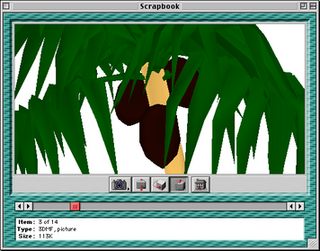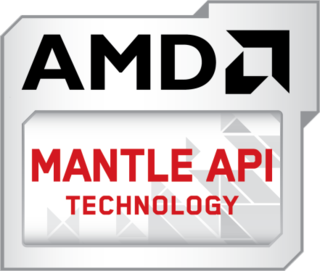
OpenGL is a cross-language, cross-platform application programming interface (API) for rendering 2D and 3D vector graphics. The API is typically used to interact with a graphics processing unit (GPU), to achieve hardware-accelerated rendering.

A scene graph is a general data structure commonly used by vector-based graphics editing applications and modern computer games, which arranges the logical and often spatial representation of a graphical scene. It is a collection of nodes in a graph or tree structure. A tree node may have many children but only a single parent, with the effect of a parent applied to all its child nodes; an operation performed on a group automatically propagates its effect to all of its members. In many programs, associating a geometrical transformation matrix at each group level and concatenating such matrices together is an efficient and natural way to process such operations. A common feature, for instance, is the ability to group related shapes and objects into a compound object that can then be manipulated as easily as a single object.
Fahrenheit was an effort to create a unified high-level API for 3D computer graphics to unify Direct3D and OpenGL. It was designed primarily by Microsoft and SGI and also included work from an HP-MS joint effort.
X3D is a royalty-free ISO/IEC standard for declaratively representing 3D computer graphics. File format support includes XML, ClassicVRML, Compressed Binary Encoding (CBE) and a draft JSON encoding. X3D became the successor to the Virtual Reality Modeling Language (VRML) in 2001. X3D features extensions to VRML, the ability to encode the scene using an XML syntax as well as the Open Inventor-like syntax of VRML97, or binary formatting, and enhanced application programming interfaces (APIs).
In computer science, a lock or mutex is a synchronization primitive: a mechanism that enforces limits on access to a resource when there are many threads of execution. A lock is designed to enforce a mutual exclusion concurrency control policy, and with a variety of possible methods there exists multiple unique implementations for different applications.
OpenGL Performer, formerly known as IRIS Performer and commonly referred to simply as Performer, is a commercial library of utility code built on top of OpenGL for the purpose of enabling hard real-time visual simulation applications. OpenGL Performer was developed by SGI which continues to maintain and enhance it. OpenGL Performer is available for IRIX, Linux, and several versions of Microsoft Windows. Both ANSI C and C++ bindings are available.
OpenGL++ was a graphics library written in C++ that supported object-oriented data structures on top of the OpenGL 3D graphics system. The project started as the result of a partnership between SGI, IBM and Intel, and later, Digital Equipment Corporation. It was intended to provide a higher level API than the "bare metal" support of OpenGL, as well as being an implementation for Java3D. Work on OpenGL++ ended when SGI decided to partner with Microsoft instead, leading to the Fahrenheit project, which also died.

QuickDraw 3D, or QD3D for short, is a 3D graphics API developed by Apple Inc. starting in 1995, originally for their Macintosh computers, but delivered as a cross-platform system.
The Khronos Group, Inc. is an open, non-profit, member-driven consortium of 170 organizations developing, publishing and maintaining royalty-free interoperability standards for 3D graphics, virtual reality, augmented reality, parallel computation, vision acceleration and machine learning. The open standards and associated conformance tests enable software applications and middleware to effectively harness authoring and accelerated playback of dynamic media across a wide variety of platforms and devices. The group is based in Beaverton, Oregon.
Parallel rendering is the application of parallel programming to the computational domain of computer graphics. Rendering graphics can require massive computational resources for complex scenes that arise in scientific visualization, medical visualization, CAD applications, and virtual reality. Recent research has also suggested that parallel rendering can be applied to mobile gaming to decrease power consumption and increase graphical fidelity. Rendering is an embarrassingly parallel workload in multiple domains and thus has been the subject of much research.

OpenSceneGraph is an open-source 3D graphics application programming interface, used by application developers in fields such as visual simulation, computer games, virtual reality, scientific visualization and modeling.

GDK is a library that acts as a wrapper around the low-level functions provided by the underlying windowing and graphics systems. GDK lies between the display server and the GTK library, handling basic rendering such as drawing primitives, raster graphics (bitmaps), cursors, fonts, as well as window events and drag-and-drop functionality.
UNIGINE is a proprietary cross-platform game engine developed by UNIGINE Company, used in simulators, virtual reality systems, serious games and visualization. UNIGINE can support large open worlds including entire planets. It has an advanced 3D renderer that supports OpenGL 4 and DirectX 11. UNIGINE SDK releases an update every three to four months.
Immediate mode in computer graphics is a design pattern of API design in graphics libraries, in which
oneAPI Threading Building Blocks, is a C++ template library developed by Intel for parallel programming on multi-core processors. Using TBB, a computation is broken down into tasks that can run in parallel. The library manages and schedules threads to execute these tasks.
In computer science and visualization, a canvas is a container that holds various drawing elements. It takes its name from the canvas used in visual arts. It is sometimes called a scene graph because it arranges the logical representation of a user interface or graphical scene. Some implementations also define the spatial representation and allow the user to interact with the elements via a graphical user interface.

Mantle was a low-overhead rendering API targeted at 3D video games. AMD originally developed Mantle in cooperation with DICE, starting in 2013. Mantle was designed as an alternative to Direct3D and OpenGL, primarily for use on personal computers, although Mantle supports the GPUs present in the PlayStation 4 and in the Xbox One. In 2015, Mantle's public development was suspended and in 2019 completely discontinued, as DirectX 12 and the Mantle-derived Vulkan rose in popularity.

GTK Scene Graph Kit (GSK) is the rendering and scene graph API for GTK introduced with version 3.90. GSK lies between the graphical control elements (widgets) and the rendering.
Vulkan is a low-overhead, cross-platform API, open standard for 3D graphics and computing. Vulkan targets high-performance real-time 3D graphics applications, such as video games and interactive media. In contrast to the older OpenGL and Direct3D 11 APIs, Vulkan is intended to offer higher performance and more efficient CPU and GPU usage. It provides a considerably lower-level API for the application than the older APIs, making Vulkan comparable to Apple's Metal API and Microsoft's Direct3D 12. In addition to its lower CPU usage, Vulkan is designed to allow developers to better distribute work among multiple CPU cores.





